
Wine Culture and Information since 2002 - Volume 22
 Wine Culture and Information since 2002 - Volume 22 |
|
GorgonzolaGorgonzola, the homonymous city, near Milan, with “stracchino di Gorgonzola” began the fascinating adventure of a cheese, which is still very famous and appreciated all over the world |
|
Gorgonzola is a cheese which can be used in many gastronomic preparations. Many chefs use it to prepare main courses, second courses as well as desserts. Connoisseurs love to taste it on a slice of plain bread or on a slice of hot polenta.
|
|
The exact date to identify the origin of Gorgonzola is not known, however it surely has a tradition long of many years. Going back in time, it can be noticed reality and traditions are mixed together in a more or less credible legends. Some sources want its origin from the eastern slopes of northern Grigna, in the valley of Valvassina, precisely in Pasturo, in the province of Lecco. The area is rich in natural caves, where room temperature is constant between 6 and 12° C (42-53° F), an area of long cheese making traditions, perfect for aging cheese. Some believe the origin is from the homonymous city, near Milan, an important center of trading for herd, around the year 879.
The name Gorgonzola is attributed only later on: the first names with which it was known were stracchino di Gorgonzola (Gorgonzola's stracchino cheese), stracchino verde (green stracchino) or stracchino erborinato (moulded stracchino), because of the green stripes similar to parsley, called erborin in the local dialect. However, the area of Gorgonzola remained the main center for production and trading for a long time. In the Middle Ages, in the area near Milan, stracchino di Gorgonzola - at that time it was known with this name - was used to treat gastrointestinal diseases. As opposed to other cheeses, Gorgonzola had not an immediate success, however its ascent was slow and constant. Since the beginning of 1900's, the fame of Gorgonzola spread abroad, especially in England, France and Germany. Two decrees, the first in 1955 and the second in 1977, delimited the area of production and aging, becoming a denominazione di origine tutelata (denomination of safeguarded origin). In the postwar period, the technique of production was improved, therefore allowing higher quality, better hygienic conditions for all the production phases as well as constant organoleptic characteristics. The old technique was replaced with a new one, also encouraged by a cheaper production process. Gorgonzola continued to spread and to be successful, this lead to the first imitations, moulded cheeses began to be produced in many parts of Europe. Gorgonzola producers, which have been successful in transforming their work in a profitable business, began to get worried and in the 1950's began to set the first countermeasures. The first results was of 1954, when the law 125 was promulgated and which regulated typical productions and origin. The subsequent decree gave Gorgonzola cheese the “denominazione di origine protetta” (protected designation of origin) (Rule E.E.C. 2081/92), like Parmesan, Roman Pecorino cheese and others. In order to better guarantee quality, in 1970, “Consorzio per la Tutela del formaggio Gorgonzola” (Consortium for the Safeguarding of Gorgonzola Cheese) was founded, which with its inspectors ensured full compliance with the production disciplinary, in Italy as well as abroad. Gorgonzola has been recognized by the European Community as a DOP product with the Regulation 1107 of June 12th, 1996.
|
||||||||
|
Gorgonzola cheese can be produced only with the milk from the areas defined in the DOP disciplinary, located in two Italian regions: Lombardy and Piedmont. As for Piedmont are included the following provinces: Biella, Cuneo, Novara, Verbania, Vercelli and the territory of Casale Monferrato; as for Lombardy, the provinces of Bergamo, Brescia, Como, Cremona, Lecco, Lodi, Pavia and Varese. Gorgonzola is made from pasteurized cow whole and homogenized milk. The milk has to be pure - it must not be contaminated by any disinfectant, antibiotic or pesticide - otherwise the milk enzymes and the formation of moulds are seriously compromised or the quality of the product would be inferior. For this reason, it is important the scrupulous selection of the raw matter. Milk is poured into kettles and brought at a temperature of 28-32° C (82-89° F), then adding milk enzymes Lactobacillus bulgaricus and Streptococcus termophilus (the same used for the production of yogurt), rennet and selected penicillium spores, in particular Penicillium roqueforti. Once the mixture has curdled, the curd is broken up, while putting a lot of attention in creating an environment rich in oxygen in order to favor the development of Penicillium, and then transferred in special containers in order to drain the whey. This phase is very delicate: here the experience and the art of the dairyman are very important. After few minutes, the curd is placed in layers in containers known as “fassiroli” or “fascere”, in a quantity of approximately 14-15 Kg. each, and then it is allowed to stay for 36 hours in the forms, where it is continuously turned over, in order to favor a further draining of whey. This phase of production is done at a temperature of 5° C (41° F). When the curd has acquired the necessary consistency, it is marked with the logo of the Consortium and the number identifying the producer, then it is transferred in order to undergo the phase of salting. In this phase, the forms are transferred to a room, the so-called “purgatory” (cellars with a temperature of 20-22° C (68-71° F) and a humidity of 90-95% suitable for aging). The cheeses remain in the maturing cellars, at a temperature of 2-7° C (35-44° F) and a humidity of 85-95%, for a period from 50 to 90 days, according to the type (sweet or piquant). After three or four weeks, the cheeses are holed. Long metallic needles hole the cheeses in order let the air in, therefore allowing the development of the cultures previously introduced in the curd. The air creates the ideal and natural conditions for the development of Penicillium, responsible for the blue-green veining making Gorgonzola cheese unique. At the end of the aging process, the cheeses undergo a further check in order to assess quality. The forms found to have the right quality are then cut in two or more pieces and each piece is wrapped in aluminum foil with the “g” trademark. Before being commercialized, Gorgonzola must undergo an aging process, which is of two months for the sweet style, three months for the piquant one. The present production is of about 3,600,000 forms, 430,000 quintals of product, 28-29% of which is exported. Foreign countries, in which are found most of Gorgonzola consumers are France, Germany - which import more than 50% of total exports - followed by Switzerland, Great Britain, Belgium, Holland, Austria, United States of America and Canada.
|
||||
|
Gorgonzola is a straw-white raw curd cheese, whose green veining is the result of the moulding process. The external crust is hard, rough and reddish. There are three different styles of Gorgonzola cheese:
Milk enzymes are indispensable for the production of this cheese and are similar to the bacilli contained in yogurt and even more, to the ones used for the products commonly sold in pharmacies and used against diarrhea. The mould spores responsible for the distinctive greenish veining of the cheese belong to the Penicillium Roqueforti species, closely related to the more famous Penicillium Notatum from which penicillin is produced. Perhaps, it is because of this people in charge of aging Gorgonzola are particularly resistant to infective diseases, or at least it is believed so. However this is the border between legend and reality. In any case, milk enzymes, moulds and penicillin - or at least the substances produced from their metabolism - surely have a positive effect on human organism. Gorgonzola, according to a nutritional point of view, is rich in vitamins, mineral salts, proteins, with a moderate quantity of fats. In short, 100 grams of Gorgonzola contains: 19 gr. of proteins; 26 gr. of fats; 360 mg. of phosphor; 420 mg. of calcium; 120 mg. of potassium; 70 mg. of cholesterol; vitamins A, B1, B2, B6, B12 and PP. Hundred grams of Gorgonzola provide 330 kcal. To fully enjoy the organoleptic qualities of sweet Gorgonzola, it is best to take it out from the fridge at least half an hour before serving. It is a very special cheese, which must be consumed fresh, it is a live product, continuously aging: in case it is kept for a long time in the fridge, it can even get a remarkable strong taste, in this case it can be mixed with cream and butter and used for the preparation of fine sauces. Thanks to its organoleptic characteristics, Gorgonzola is suitable for many gastronomic preparations. Many chefs use it to prepare main courses, second courses and even desserts. Connoisseurs like to enjoy it on a slice of plain bread or on a slice of hot polenta. Originally, all the cheeses are marked on both faces, but this does not interest the consumer. To be sure of having bought an authentic Gorgonzola, before buying, it is best to make sure the “g” trademark is printed on the aluminum foil wrapping the product. This logo is exclusive and distinguishes the original product.
|
AquavitaeReview of Grappa, Distillates and Brandy |
|
|
| Distillates are rated according to DiWineTaste's evaluation method. Please see score legend in the "Wines of the Month" section. |
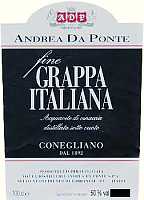
|
|
Fine Grappa Italiana |
|
| Andrea Da Ponte (Veneto, Italy) | |
| Raw matter: Pomace of Merlot and Cabernet | |
| Price: € 14.00 - 1l | Score: |
| This grappa is colorless, limpid and crystalline. The nose denotes intense, clean and pleasing aromas of pear, raspberry, black cherry, hazelnut and licorice, with almost imperceptible alcohol pungency. In the mouth has intense flavors with perceptible alcohol pungency which tends to dissolve rapidly, good correspondence to the nose, balanced sweet hint, pleasing smoothness. The finish is persistent with flavors of raspberry and licorice. This grappa is distilled with traditional continuous and discontinuous alembic stills. Alcohol 50%. | |
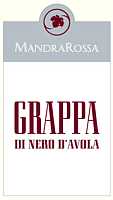
|
|
Grappa di Nero d'Avola Mandrarossa |
|
| Cantine Settesoli (Sicily, Italy) | |
| (Distiller: Fratelli Brunello) | |
| Raw matter: Pomace of Nero d'Avola | |
| Price: € 15.00 - 50cl | Score: |
| The grappa is colorless, limpid and crystalline. The nose reveals intense, clean and pleasing aromas of plum, black cherry, licorice, hazelnut and blackberry, with almost imperceptible alcohol pungency. In the mouth has intense flavors with perceptible alcohol pungency which tends to dissolve rapidly, balanced sweet hint. The finish is persistent with flavors of plum and blackberry. This grappa is produced with a discontinuous steam operated alembic still. Alcohol 45%. | |
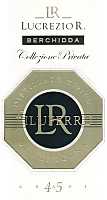
|
|
Filuferru Collezione Privata |
|
| Lucrezio R. (Sardinia, Italy) | |
| Raw matter: Pomace of white and red grapes | |
| Price: € 18.00 - 50cl | Score: |
| This distillate is colorless, limpid and crystalline. The nose reveals intense, clean and pleasing aromas of anise, apple, raspberry, plum, peach and licorice, with almost imperceptible alcohol pungency. In the mouth has intense flavors with perceptible alcohol pungency, dry taste, balanced sweet hint. The finish is persistent with flavors of anise, plum and apple. This Filuferru is distilled with a bainmarie alembic still. Alcohol 45%. | |

|
|
Grappa di Erbaluce di Caluso |
|
| Revel Chion (Piedmont, Italy) | |
| Raw matter: Pomace of Erbaluce | |
| Price: € 12.50 - 50cl | Score: |
| This grappa is colorless, limpid and crystalline. The nose reveals intense, clean and pleasing aromas of apple, plum, mown grass, hazelnut and broom, with almost imperceptible alcohol pungency. In the mouth has intense flavors with perceptible alcohol pungency which tends to dissolve rapidly, pleasing roundness, balanced sweet hint. The finish is persistent with flavors of apple, plum and hazelnut. This grappa is distilled with a steam operated alembic still. Alcohol 45%. | |
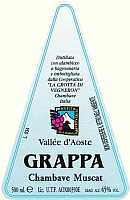
|
|
Grappa Chambave Muscat 1999 |
|
| La Crotta di Vegneron (Vallée d'Aoste, Italy) | |
| Raw matter: Pomace of Muscat Blanc | |
| Price: € 24.50 - 50cl | Score: |
| This grappa is colorless, limpid and crystalline. The nose reveals intense, clean and pleasing aromas of grape, peach, sage, apple, pear and honey, with almost imperceptible alcohol pungency. In the mouth has intense flavors with perceptible alcohol pungency which tends to dissolve rapidly, pleasing smoothness, balanced sweet hint. The finish is persistent with flavors of grape, peach and pear. This grappa is distilled in bainmarie alembic stills. Alcohol 45%. | |
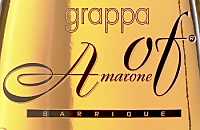
|
|
Grappa of Amarone Barrique |
|
| Bonollo Umberto (Veneto, Italy) | |
| Raw matter: Pomace of Corvina, Rondinella and Molinara | |
| Price: € 37.00 - 70cl | Score: |
| This grappa shows a brilliant amber yellow color, limpid and colorless. The nose reveals intense, clean, pleasing and refined aromas of prune, dried fig, licorice, star anise, black cherry, honey, tobacco, hazelnut, nutmeg, cocoa and white pepper, with almost imperceptible alcohol pungency. In the mouth has intense flavors with perceptible alcohol pungency which tends to dissolve rapidly, pleasing smoothness, balanced sweet hint, agreeable. The finish is persistent with flavors of prune, hazelnut and dried fig. This grappa is produced with the double distillation system and it is aged in barrique. Alcohol 42%. | |
Wine Parade |
|
|
| The best 15 wines according to DiWineTaste's readers. To express your best three wines send us an E-mail or fill in the form available at our WEB site. |
| Rank | Wine, Producer | |
|---|---|---|
| 1 |
| Amarone della Valpolicella Classico 1998, Santa Sofia (Italy) |
| 2 |
| Trento Talento Brut Riserva Methius 1998, Dorigati (Italy) |
| 3 |
| Colli Orientali del Friuli Rosazzo Bianco Terre Alte 2002, Livio Felluga (Italy) |
| 4 |
| Aglianico del Vulture La Firma 2002, Cantine del Notaio (Italy) |
| 5 |
| Riesling Central Otago 2004, Felton Road (New Zealand) |
| 6 |
| Palazzo della Torre 2000, Allegrini (Italy) |
| 7 |
| Brunello di Montalcino 1999, Castello Banfi (Italy) |
| 8 |
| Montepulciano d'Abruzzo Riparosso 2001, Illuminati (Italy) |
| 9 |
| Amarone della Valpolicella Classico 2000, Zenato (Italy) |
| 10 |
| Wine Obsession 2001, Vignamaggio (Italy) |
| 11 |
| Chablis Grand Cru Les Clos 2002, Domaine Billaud-Simon (France) |
| 12 |
| Rêve 2001, Velenosi Ercole (Italy) |
| 13 |
| Notarpanaro 1999, Taurino (Italy) |
| 14 |
| Chianti Classico Riserva Novecento 2000, Dievole (Italy) |
| 15 |
| Harmonium 2001, Firriato (Italy) |
|
||||||||
|
DiWineTaste Polls
|
| |||||||
Privacy Policy | |||||||


| Copyright © 2002-2024 Antonello Biancalana, DiWineTaste - All rights reserved |
| All rights reserved under international copyright conventions. No part of this publication and of this WEB site may be
reproduced or utilized in any form or by any means, electronic or mechanical, without permission in writing from DiWineTaste. |